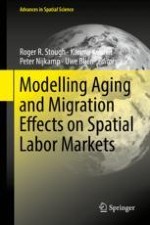The aging and migration megatrends and their impact on spatial – regional and local – labor market performance is the core theme of this book, and thus together define its scope and focus. The contributions provide an overview of key aging and migration issues in various countries together with analyses of their varied impacts on regional labor markets. Systematic database research and related empirical analyses are used to map out the complex and dynamic nature of these trends, while cutting-edge economic and modeling techniques are used to analyze them. In closing, the book critically reviews and assesses selected policy measures designed to cope with the effects of aging and migration on regional labor markets.
